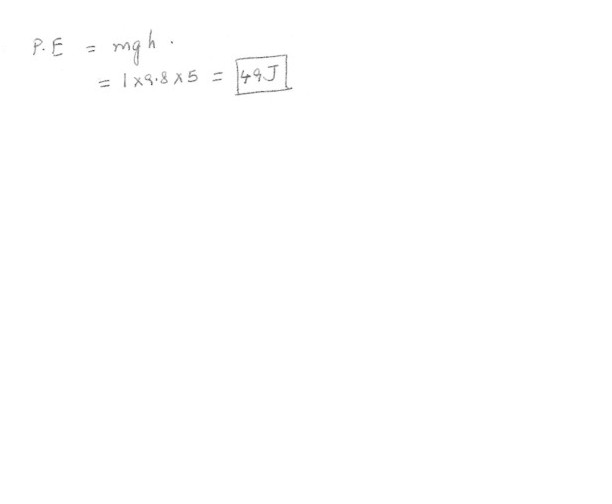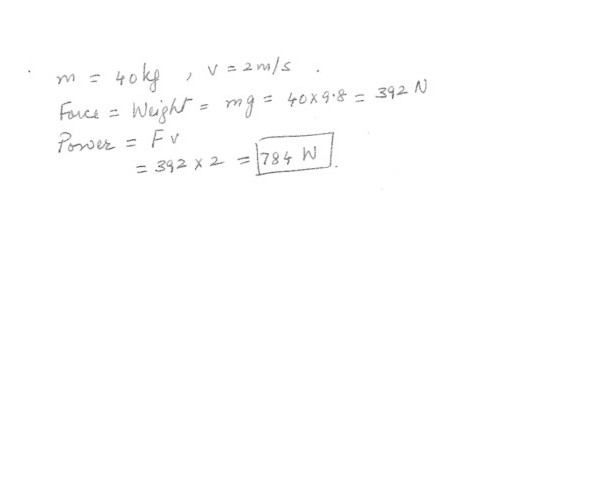Physics Work,Power & Energy Level: High School
From the top of a 75.0 m high building , a 1.00 kg ball is thrown directly downward with an initial speed of 8.00 m/s . If the ball reaches the ground with a speed of 32.0 m/s , the mechanical energy lost to friction is equal to :a) 0 J
b) 255 J
c) 480 J
d) 735 J
e) 767 J

Physics Work,Power & Energy Level: High School
Inelastic Collision
Block 1, mass m1= 7.10 kg , moves along a frictionless air track with speed v1 = 11.0 m/s . It collides with block 2 of mass m2 = 59.0 kg , Which moves initially with speed 4.30 m/s , toward the first block , The block stick together after the collision .a) Find the magnitude P1 of the total initial momentum of the two-block system .
b) Find , the magnitude of the final velocity of the two-block system .
c) What is the change delta K= K final – K initial in the system’s kinetic energy due to the collision ?

Physics Work,Power & Energy Level: High School
A small pond of 2 meters diameter holds 500 kg of water . If energy from sunlight is absorbed by the pond’s surface at a rate of 400 J/s per square meter , with no energy losses , what energy does the pond absorb per sound ?
Physics Work,Power & Energy Level: High School
Electric Power
What is the power output of an electrical device that uses 400 Joules of energy in 4 seconds ?
Physics Work,Power & Energy Level: High School
A child of mass 20 kilograms slides down a playground slide . At a particular instant , her speed is 2 m/s . What is the child’s kinetic energy ?
Physics Work,Power & Energy Level: High School
What is the gravitational potential energy of a ball of mass 1 kg when it is 5 meters above the ground ?
Physics Work,Power & Energy Level: High School
Power
What power is necessary for a forklift to lift a 40 kilogram box against the force of gravity at a speed of 2 m/s ?
Physics Work,Power & Energy Level: High School
Calculate the work done on a box that slides 2 meters along a horizontal surface under the application of a 30 Newton horizontal force .
Physics Work,Power & Energy Level: High School
Suppose the energy of an object is given in Joules by E = 5x^2 + 5x , where x is the position of the object . Determine the objects position (s) when E = 30 J .
Physics Work,Power & Energy Level: High School
Elastic P.E
If 20 Joules of energy are stored in a spring of spring constant k = 5 N/m , how is the spring extended ?
Physics Work,Power & Energy Level: High School
Vertical Loop
The maximum acceleration a human can stand is about 7.0 g . What is the minimum radius of curvature that a jet plane’s pilot pulling out of a vertical dive can tolerate at a speed of 250 m / s ?
Physics Work,Power & Energy Level: High School
Conservation of Linear Momentum
A truck of mass 3000 kg traveling due east collides with a car of mass 1500 kg traveling due north . The two stick together and skid at an angle 45.0 deg north of east for a distance of 20.0 m . The coefficient of friction Mk = 1.000 . Calculate the speed of each vehicle before the collision .
Physics Work,Power & Energy Level: High School
Vertical Circle , Centrifugal Force
In an atomic clothe drier , a hollow cylinder moves the clothe on a vertical circle (radius r = 0.31 m ) , as the drawing shows at “click here” . The appliance is designed so that the clothes tumble gently as the dry . This means that when a piece of clothing reaches an angle of theta above the horizontal , it loses contact with the wall cylinder and falls onto the clothes below . How many revolutions per second should the cylinder make in order that the clothes lose contact with the wall when theta = 66.0 degree ?
Physics Work,Power & Energy Level: High School
Vertical Circle , Centrifugal Force
A roller coaster at an amusement park has a dip that bottoms out in a vertical circle of radius r . A passenger feels the seat of the car pushing upward on her with a force equal to four times her weight as she goes through the dip . If r = 16.0 m , how fast is the roller coaster traveling at the bottom of the dip ?
Physics Work,Power & Energy Level: High School
Vertical Circle
The drawing shows a version of the loop-the-loop trick for a smaller car . If the car is given an initial speed of v = 3.2 m / s . what is the largest values that radius r can have if the car is to remain in contact with the circular track at all times ?
